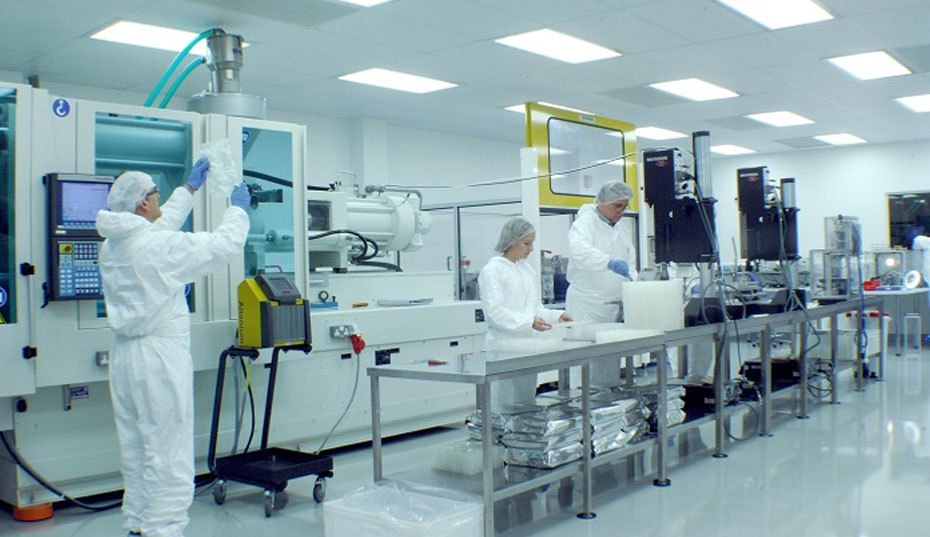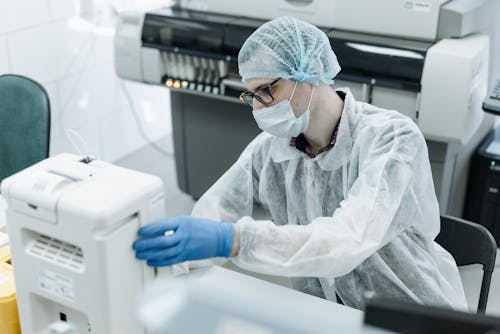
A medical injection moulding cleanroom is a sterile environment that is designed to limit airborne particles, provide a stable and controlled temperature, and create a safe working environment for medical device manufacturing. Such cleanrooms are typically used in pharmaceutical and medical device manufacturing, medical research, and medical device assembly. In this guide, we will explore what medical injection moulding cleanrooms are and the many benefits they provide. We will also discuss the standards, types, and design considerations for medical injection moulding cleanrooms and how to build, maintain, and test them.
What is a medical injection moulding cleanroom?
A medical injection moulding cleanroom is a sterile, isolated space that is designed to protect the integrity of medical devices, pharmaceuticals, and biologics. It is typically used in the production and assembly of medical devices, biologics, and pharmaceuticals. The main purpose of a medical injection moulding cleanroom is to reduce the possibility of contamination and provide a safe and efficient work environment.
In a medical injection moulding cleanroom, air is filtered to reduce the number of airborne particles, providing a clean and safe environment for medical device manufacturing, pharmaceuticals, and biologics production. The air is also carefully monitored to ensure that it is free of contaminants and any other airborne particles. In order to maintain the cleanliness of the air, medical injection moulding cleanrooms are typically equipped with high-efficiency particulate air (HEPA) filters and laminar flow systems.
In addition to air filtration, medical injection moulding cleanrooms are also designed to maintain a controlled temperature and humidity level. The temperature and humidity are typically monitored and controlled to ensure the optimal environment for the manufacturing process. The air pressure is also carefully monitored and controlled to ensure that the air flows in one direction, preventing the spread of contaminants.
Benefits of medical injection moulding cleanroom
Medical injection moulding cleanrooms provide a number of benefits for medical device manufacturing, pharmaceuticals, and biologics production. The primary benefit of a medical injection moulding cleanroom is that it is a sterile and isolated environment, which helps to reduce the risk of contamination and provide a safe and efficient working environment.
In addition, medical injection moulding cleanrooms are designed to be energy efficient, which can help to reduce energy costs and improve the overall efficiency of the manufacturing process. The air filtration systems used in medical injection moulding cleanrooms also help to reduce the risk of cross-contamination and airborne particles, providing a safe and clean environment for medical device manufacturing.
Medical injection moulding cleanrooms also provide a number of other benefits. They can help to reduce noise levels, which can help to reduce stress levels for workers. They also help to maintain a stable and controlled temperature and humidity level, which can help to improve the quality of the products being manufactured. Finally, medical injection moulding cleanrooms help to reduce the risk of infection and cross-contamination, which can help to improve the quality of the products being manufactured.
Medical injection moulding cleanroom standards
Medical injection moulding cleanrooms must meet certain standards in order to be effective. The most common standards for medical injection moulding cleanrooms are:
- ISO 14644-1: Cleanroom classification
- ISO 14644-2: Cleanroom design and construction
- ISO 14644-3: Cleanroom operations
- ISO 14644-4: Cleanroom monitoring
- ISO 14644-5: Cleanroom certification
These standards are designed to ensure that medical injection moulding cleanrooms are properly built, maintained, and monitored. The standards also outline the requirements for air filtration, ventilation, temperature, and humidity control.
Types of medical injection moulding cleanrooms
There are a number of different types of medical injection moulding cleanrooms. The most common types of cleanrooms used in medical device manufacturing are:
- Class 10,000 cleanroom
- Class 100,000 cleanroom
- Class 1,000,000 cleanroom
The type of medical injection moulding cleanroom you use depends on the type of product being manufactured, the level of cleanliness required, and the size of the space.
Class 10,000 cleanrooms are typically used for medical device assembly, medical research, and medical device manufacturing. These cleanrooms are designed to provide a sterile and isolated environment and are usually equipped with HEPA filters and laminar flow systems.
Class 100,000 cleanrooms are typically used for medical device manufacturing and medical research. These cleanrooms are designed to provide a higher level of cleanliness than Class 10,000 cleanrooms and are usually equipped with HEPA filters, laminar flow systems, and air showers.
Class 1,000,000 cleanrooms are typically used for pharmaceutical manufacturing. These cleanrooms are designed to provide the highest level of cleanliness and are usually equipped with HEPA filters, laminar flow systems, and air showers.
How to design a medical injection moulding cleanroom
Designing a medical injection moulding cleanroom should be done with careful consideration of the type of product being manufactured and the level of cleanliness required. The design should also consider the space available, the size of the cleanroom, and the type of air filtration and ventilation systems that will be used.
When designing a medical injection moulding cleanroom, it is important to consider the type of materials being used, the layout of the space, and the type of air filtration and ventilation systems. The materials used should be non-porous and non-absorbent, and should be easy to clean and maintain. The layout of the space should be designed to reduce the risk of cross-contamination and airborne particles, and should be designed to optimize the air flow. The type of air filtration and ventilation systems should be chosen based on the type of product being manufactured, the level of cleanliness required, and the size of the space.
It is also important to consider the type of cleanroom equipment that will be used. This includes the type of air filtration system, the type of ventilation system, and the type of monitoring equipment that will be used. The type of equipment chosen should be based on the type of product being manufactured, the level of cleanliness required, and the size of the space.
Finally, it is important to consider the type of personnel that will be working in the medical injection moulding cleanroom. The type of personnel should be chosen based on the type of product being manufactured, the level of cleanliness required, and the size of the space.
Building a medical injection moulding cleanroom
Once the design of the medical injection moulding cleanroom is complete, it is time to begin the construction process. The construction process should be done with careful consideration of the design and the type of materials being used.
The first step in the construction process is to install the air filtration and ventilation systems. The type of air filtration and ventilation system should be chosen based on the type of product being manufactured, the level of cleanliness required, and the size of the space. The air filtration system should be installed according to the manufacturer's instructions and should be tested to ensure that it is working properly.
The next step in the construction process is to install the cleanroom equipment. This includes the type of air filtration system, the type of ventilation system, and the type of monitoring equipment that will be used. The equipment should be installed according to the manufacturer's instructions and should be tested to ensure that it is working properly.
The final step in the construction process is to install the cleanroom walls. The walls should be constructed of non-porous and non-absorbent materials and should be easy to clean and maintain. Once the walls are installed, the cleanroom should be tested to ensure that it meets the required standards.
Maintaining a medical injection moulding cleanroom
Once a medical injection moulding cleanroom has been built, it is important to maintain it properly. Proper maintenance will help to ensure that the cleanroom is providing a safe and efficient working environment and that the products being manufactured are of the highest quality.
The first step in maintaining a medical injection moulding cleanroom is to regularly test the air filtration and ventilation systems. The air filtration and ventilation systems should be tested to ensure that they are working properly and to ensure that they are providing the required levels of clean air.
The next step in maintaining a medical injection moulding cleanroom is to regularly clean and maintain the cleanroom equipment. All of the cleanroom equipment should be regularly cleaned and maintained to ensure that it is working properly and to ensure that it is providing the required levels of cleanliness.
The final step in maintaining a medical injection moulding cleanroom is to regularly monitor the temperature and humidity levels. The temperature and humidity levels should be monitored to ensure that the cleanroom is providing the optimal environment for the manufacturing process.
Medical injection moulding cleanroom equipment
In order to maintain a medical injection moulding cleanroom, it is important to have the right equipment. The type of equipment used in a medical injection moulding cleanroom should be based on the type of product being manufactured and the level of cleanliness required. Typical equipment used in medical injection moulding cleanrooms includes:
- Air filtration systems
- Ventilation systems
- Air showers
- HEPA filters
- Laminar flow systems
- Monitoring equipment
- Cleaning equipment
The air filtration and ventilation systems should be chosen based on the type of product being manufactured and the level of cleanliness required. The air showers, HEPA filters, and laminar flow systems should be chosen based on the size of the space and the type of product being manufactured. The monitoring equipment should be chosen based on the type of product being manufactured and the level of cleanliness required. Finally, the cleaning equipment should be chosen based on the type of product being manufactured and the level of cleanliness required.

Medical injection moulding cleanroom testing
Once a medical injection moulding cleanroom has been built and maintained, it is important to test it to ensure that it is providing the required levels of cleanliness and safety. The most common tests used to test medical injection moulding cleanrooms are:
- Particle testing
- Airflow testing
- Temperature and humidity testing
- Vibration testing
The particle testing is used to test for airborne particles and the number of particles in the air. The airflow testing is used to test the air flow and ensure that it is flowing in one direction. The temperature and humidity testing is used to test the temperature and humidity levels in the cleanroom. Finally, the vibration testing is used to test for vibrations that could cause damage to the cleanroom equipment or products.
Conclusion
Medical injection moulding cleanrooms are a safe and efficient way to manufacture and assemble medical devices, biologics, and pharmaceuticals. They provide a sterile and isolated environment that helps to reduce the risk of contamination and provide a safe and efficient working environment. Medical injection moulding cleanrooms must meet certain standards in order to be effective and there are a number of different types of cleanrooms that can be used. The design and construction of a medical injection moulding cleanroom should be done with careful consideration of the type of product being manufactured and the level of cleanliness required. Finally, it is important to maintain and test a medical injection moulding cleanroom to ensure that it is providing the required levels of cleanliness and safety.
By following this comprehensive guide, you can unlock the many benefits of medical injection moulding cleanrooms and create a safe and efficient working environment for your medical device manufacturing, biologics, and pharmaceuticals production.





